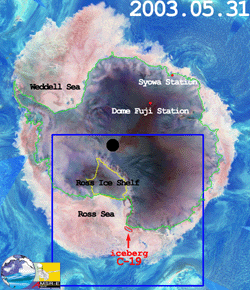 |
(Fig.1 AMSR-E Image of Antarctica dated 31 May 2003)
 Lager Image Lager Image
|
Giant iceberg drifts around Antarctica.
Every day, AMSR-E observes a drifting giant iceberg, which broke off from the Ross Ice Shelf in May of last year (2002). The iceberg is 17 by 109 nautical miles, roughly the size of Long Island. The image from AMSR-E in Figure 1 shows Antarctica on May 31, 2003. During the warm summer in Japan, Antarctica, which is in the southern hemisphere, enters the season of polar night when the sun does not rise. At Showa Station (69S 36.6E), which is the base of the Japanese Antarctic Research Expedition, the Sun cannot be seen from June 1 to July 14, or about one and a half months. The iceberg was designated C-19 and calved off the Ross Ice Shelf in May 2002. The Ross Ice Shelf is located on the other side of Showa Station and is the largest in Antarctica.
The area around the South Pole is black in Figure 1 because AMSR-E cannot acquire data there.
|